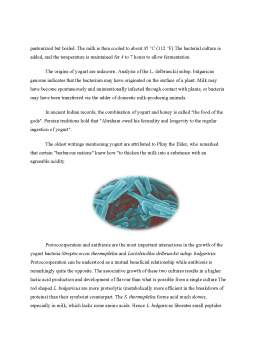Extras din proiect
1.Introduction
Yogurt is a fermented milk product produced by bacterial fermentation of milk. The bacteria used to make yogurt are known as "yogurt cultures". Fermentation of lactose by these bacteria produces lactic acid, which acts on milk protein to give yogurt its texture and its characteristic tang.
Worldwide, cow's milk, the protein of which is mainly casein, is most commonly used to make yogurt. Milk from water buffalo, goats, ewes, mares, camels, and yaks however, is also used to produce yogurt in various parts of the world.
Dairy yogurt is produced using a culture of Lactobacillus delbrueckii subsp. bulgaricus and Streptococcus thermophilus bacteria. In addition, other lactobacilli and bifidobacteria are also sometimes added during or after culturing yogurt. Some countries require yogurt to contain a certain amount of colony-forming units of microorganisms.
In Western culture, the milk is first heated to about 80 °C (176 °F) to kill any undesirable bacteria and to denature the milk proteins so that they set together rather than form curds. In some places, such as parts of India & Bangladesh curds are a desired component and milk is not pasteurized but boiled. The milk is then cooled to about 45 °C (112 °F).The bacterial culture is added, and the temperature is maintained for 4 to 7 hours to allow fermentation.
The origins of yogurt are unknown. Analysis of the L. delbrueckii subsp. bulgaricus genome indicates that the bacterium may have originated on the surface of a plant. Milk may have become spontaneously and unintentionally infected through contact with plants, or bacteria may have been transferred via the udder of domestic milk-producing animals.
In ancient Indian records, the combination of yogurt and honey is called "the food of the gods". Persian traditions hold that "Abraham owed his fecundity and longevity to the regular ingestion of yogurt".
The oldest writings mentioning yogurt are attributed to Pliny the Elder, who remarked that certain "barbarous nations" knew how "to thicken the milk into a substance with an agreeable acidity.
Protocoorperation and antibiosis are the most important interactions in the growth of the yogurt bacteria Streptococcus thermophilus and Lactobacillus delbrueckii subsp. bulgaricus. Protocoorperation can be understood as a mutual beneficial relationship while antibiosis is remarkingly quite the opposite. The associative growth of these two cultures results in a higher lactic acid production and development of flavour than what is possible from a single culture.The rod shaped L. bulgaricus are more proteolytic (metabolically more efficient in the breakdown of proteins) than their symboint counterpart. The S. thermophilus forms acid much slower, especially in milk, which lacks some amino acids. Hence L. bulgaricus liberates small peptides and amino acids, mainly valine, of which serves to enhance the growth of S. thermophilus. In return the cocci enhance the growth of L. bulgaricus by the formation of formic acid from pyruvic acid under anaerobic conditions. Under these protocooperative stimulations during combined growth of the yogurt bacteria, lactic acid is produced at a must faster rate than by that of individual pure cultures. Antibiosis is observed after certain acidity is reached. After this point, growth of S. thermophilus is halted. However, L. bulgaricus are less susceptible to acid and continues to grow. After about 3 hours post incubation, the relative amount of bacteria is equal. The more acid tolerant bacteria, L. bulgaricus, begin to overshadow its counterpart. S. thermophilus is inhibited at pH values between 4.2-4.4, while L. bulgaricus can tolerate pH values as low as 3.5-3.8. Because of this back and forth growth, to achieve a one to one ratio of these two, the incubation must be done in a controlled manner regulating growth conditions including the concentration of inoculum, time and temperature. Further, once the desired ratio is reached the product should be cooled immediately when finished
In the process of using the lactose sugar from the milk, Lactobacillus produces acid which makes the yogurt sour and a less suitable place for other microbes. This is why there is a dramatic decrease in the amount of microbes that live in the yogurt niche when compared to the milk niche. Thus the essential conversion between milk to yogurt is the acidic levels. The increase in acidic levels is the sourness that is tasted in yogurt which lacks in milk, another characteristic difference. Lactic acid also known as lactate is not good for bacteria. So, as a response to this change in environment, they excrete lactate into their environment. This again is what causes the pH to fall to become more acidic. Another effect of excreting lactate is that the protein molecules in the milk become denatured. What this means is that the proteins unfold from their normal structures and become disordered. After becoming distorted, the protein molecules begin to stick to each other forming a semi-solid matrix. Thus, this is what gives the yogurt a semi-solid state, another characteristic different from the liquid-milk.
Bibliografie
Apostu Sorin, Stanescu Vasile, Igiena, Inspectia si Siguranta Alimentelor de origine animala, Editura Risoprint, Cluj Napoca 2010.
Apostu Sorin, Managementul Calitatii Totale, Editura Risoprint, Cluj Napoca 2009
http://en.wikipedia.org/wiki/Yogurt
https://microbewiki.kenyon.edu/index.php/Yogurt
http://ir.dut.ac.za/bitstream/handle/10321/103/Hoolasi_2005.pdf?sequence=7
Preview document
Conținut arhivă zip
- Biological Risk of Yogurt Production Line.docx

























